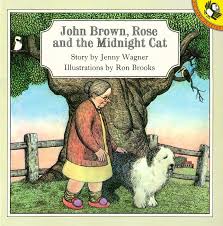1960-1970
Picture Book of the Year
The category Picture Book of the Year commenced in 1952. For many years following this no award was made so my list of books in this post will begin in 1970.
1970 John the Mouse who learned to Read by B. Randell illustrated by Noela Young was a commended book. I had a copy of John and Mouse who learned to Read in one of my school libraries. Perhaps one day I will be lucky and find a copy at a charity book sale. This is such a sweet story. In 1970 another commended book was Obstreperous by Ted Greenwood. No winner was awarded in 1970.
1974 The Bunyip of Berkeley's Creek by Jenny Wagner illustrated by Ron Brooks was the winner of the Picture Book of the Year section and commended in the Book of the Year section - a double winner! Take a look at my review.
1976 Aranea by Jenny Wagner illustrated by Ron Brooks was commended. I adore this book and have talked about it previously. I do wish this book was still in print. The 1976 winner was The Rainbow Serpent by Dick Roughsey.
1978 John Brown Rose and the Midnight Cat by Jenny Wagner illustrated by Ron Brooks was the winner. This is one of my most favourite Australian children's picture books. The reviewer in 1001 Children's Books to read before you Grow up said: "Jenny Wagner writes with the lyrical simplicity of a poet. Each word in this text is carefully chosen and perfectly pitched ... (this is a) poignant tale of love, companionship and loss." John Brown, Rose and the Midnight Cat won the inaugural Ethel Turner Prize for Children's Literature and in 1996 Australia Post issued a stamp featuring this book. In Spain John Brown is known as Oscar!
The Lighthouse Keeper's Lunch was highly commended in 1978. I have a Pinterest of books inspired by The Lighthouse Keepers's Lunch and over the following years Ronda and David Armitage produced a range of sequels to this original story.
1979 The Oath of Bad Brown Bill by Stephen Axelsen was commended. I read this book aloud to groups of Grade Five students as a part of their Australian history topic exploring the Gold Rush. This book is told in rhyme, it uses a rich vocabulary and it is a beautifully gruesome story which the students all enjoy. You can see art from this book here. Maurice Saxby says this is a book which "sends up the bushranging ethos in grossly exaggerated but wonderfully atmospheric and gruesome words and pictures." Here is a text sample:
Gross and gruesome, monster ghosts
Loathesome and befouled,
Begrimed, beslimed and horrible,
They howled and scowled and growled.
For this unit on Bushrangers I also used Bossyboots by David Cox, and Dirty Dave, the Bushranger by Roland Harvey.







No comments:
Post a Comment